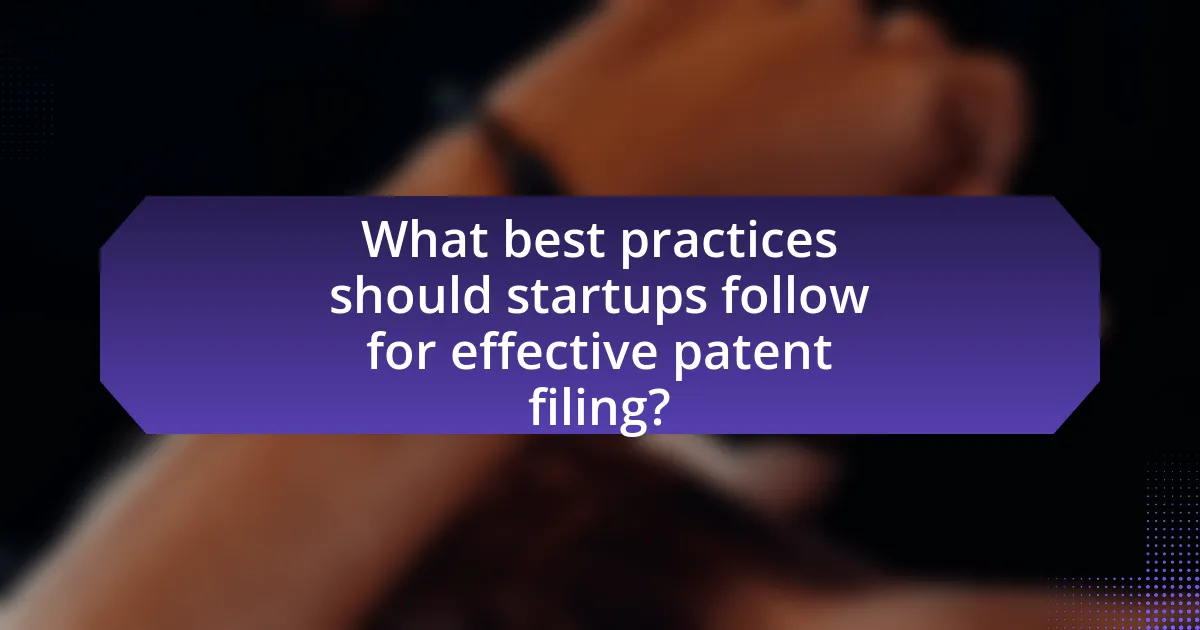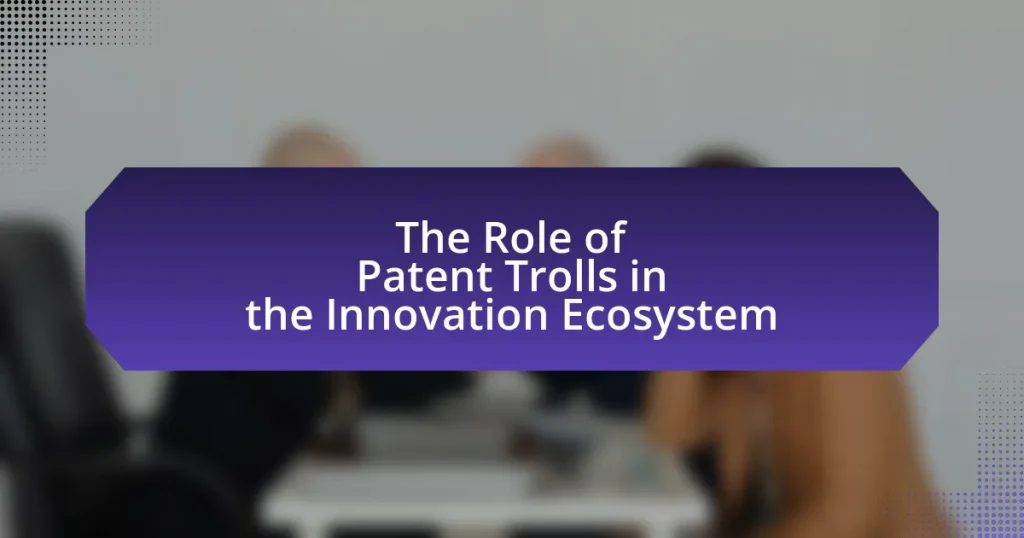Global patent filing strategies for startups are essential for protecting intellectual property and enhancing market position. Startups should prioritize key markets, utilize the Patent Cooperation Treaty (PCT) for international protection, and file patents early in the product development cycle to secure their innovations. The article outlines the importance of patent strategies in attracting investors, the risks of not having a patent strategy, and the various types of patent filings available. It also discusses the challenges startups face in global patent filing, including financial constraints and legal complexities, while providing best practices for effective patent management and resources to assist in the patent filing process.

What are Global Patent Filing Strategies for Startups?
Global patent filing strategies for startups involve prioritizing key markets, utilizing the Patent Cooperation Treaty (PCT) for international protection, and strategically timing filings to align with business goals. Startups should first identify countries where their products or services will have the most impact, as this helps in allocating resources effectively. The PCT allows startups to file a single application that can lead to patent protection in multiple countries, simplifying the process and extending the time to decide on specific jurisdictions. Additionally, startups should consider filing patents early in the product development cycle to secure intellectual property rights before public disclosure, which can enhance their valuation and attract investors. According to the World Intellectual Property Organization, the PCT system has facilitated over 3 million international patent applications since its inception, demonstrating its effectiveness for global patent strategies.
Why are patent filing strategies important for startups?
Patent filing strategies are crucial for startups because they protect intellectual property, which can be a key asset in attracting investors and gaining competitive advantage. By securing patents, startups can prevent competitors from using their innovations, thereby establishing market exclusivity. According to a study by the National Bureau of Economic Research, startups with patents are 50% more likely to receive venture capital funding, highlighting the importance of intellectual property in securing financial support. Additionally, a well-structured patent strategy can enhance a startup’s valuation, as patents often serve as indicators of innovation and potential market success.
What risks do startups face without a patent strategy?
Startups without a patent strategy face significant risks, including the potential loss of competitive advantage and increased vulnerability to intellectual property theft. Without patents, startups cannot legally protect their innovations, making it easier for competitors to copy their products or technologies. This lack of protection can lead to diminished market share and revenue, as competitors may enter the market with similar offerings at lower prices. Additionally, startups may struggle to attract investors, as the absence of a patent strategy raises concerns about the sustainability and uniqueness of their business model. According to a study by the National Bureau of Economic Research, firms with patents are more likely to secure funding, highlighting the importance of intellectual property in attracting investment.
How can a strong patent strategy enhance a startup’s market position?
A strong patent strategy can enhance a startup’s market position by providing competitive advantages through intellectual property protection. By securing patents, a startup can prevent competitors from copying its innovations, thereby establishing a unique market presence. This exclusivity can lead to increased market share, as evidenced by a study from the National Bureau of Economic Research, which found that patenting can significantly boost a firm’s market value and sales growth. Furthermore, a robust patent portfolio can attract investors, as it signals innovation and potential for profitability, ultimately strengthening the startup’s overall market position.
What types of patent filings are available to startups?
Startups have access to several types of patent filings, including provisional patents, non-provisional patents, and international patents. Provisional patents provide a temporary solution that allows startups to secure a filing date for their invention without a formal patent claim, giving them 12 months to file a non-provisional patent. Non-provisional patents require a complete application and provide full patent protection upon approval, lasting up to 20 years. International patents, often filed under the Patent Cooperation Treaty (PCT), enable startups to seek patent protection in multiple countries through a single application, streamlining the process for global expansion. These options are crucial for startups to protect their intellectual property and enhance their competitive advantage in the market.
What is the difference between provisional and non-provisional patents?
Provisional patents provide a temporary, one-year protection for an invention without a formal patent claim, while non-provisional patents require a complete application and initiate the formal examination process. Provisional patents allow inventors to secure a filing date and use the term “patent pending,” but they do not mature into an issued patent unless a non-provisional application is filed within the year. Non-provisional patents, on the other hand, undergo a thorough review by the patent office and can lead to a granted patent, offering long-term protection and enforceability.
How do international patent filings differ from domestic filings?
International patent filings differ from domestic filings primarily in their scope and procedural complexity. Domestic filings are limited to the jurisdiction of a single country, while international filings, such as those under the Patent Cooperation Treaty (PCT), allow applicants to seek patent protection in multiple countries simultaneously. The PCT process involves a single application that can lead to patents in over 150 member countries, streamlining the initial stages of patent protection. Additionally, international filings typically require adherence to more extensive regulations and translations, increasing both the cost and time involved compared to domestic filings, which are generally more straightforward and less expensive.
How can startups determine the best filing strategy for their needs?
Startups can determine the best filing strategy for their needs by assessing their business goals, market scope, and budget constraints. By clearly defining their objectives, such as whether they aim for broad international protection or focused regional coverage, startups can align their patent filing strategy accordingly. For instance, if a startup plans to enter multiple international markets, it may consider filing under the Patent Cooperation Treaty (PCT) to streamline the process and reduce costs. Additionally, analyzing competitors’ patent portfolios can provide insights into effective strategies within their industry. According to the World Intellectual Property Organization (WIPO), startups that strategically evaluate their intellectual property landscape are more likely to secure valuable patents that support their growth and innovation.
What factors should startups consider when choosing a filing strategy?
Startups should consider market potential, budget constraints, and the competitive landscape when choosing a filing strategy. Market potential involves assessing the geographical regions where the product will be sold and the likelihood of patent protection being enforced. Budget constraints are critical as filing patents can be expensive, with costs varying significantly by country; for instance, filing in the United States can cost between $5,000 to $15,000. The competitive landscape requires startups to analyze existing patents in their field to determine the likelihood of obtaining a patent and the potential for infringement. These factors collectively guide startups in making informed decisions about their patent filing strategies.
How can startups assess their innovation’s patentability?
Startups can assess their innovation’s patentability by conducting a thorough prior art search to determine if similar inventions already exist. This involves reviewing existing patents, scientific literature, and public disclosures to identify any prior knowledge that could affect the novelty of the innovation. According to the United States Patent and Trademark Office (USPTO), an invention must be novel, non-obvious, and useful to qualify for a patent. Therefore, startups should also evaluate the uniqueness of their innovation against these criteria, considering factors such as technical advancements and market applicability. Engaging with a patent attorney can further enhance this assessment, as they can provide expert insights into the patentability landscape and help navigate the complexities of patent law.

What are the challenges startups face in global patent filing?
Startups face several challenges in global patent filing, including high costs, complex legal requirements, and varying patent laws across jurisdictions. The financial burden of filing patents in multiple countries can be prohibitive, as fees for applications, translations, and legal assistance can accumulate quickly. Additionally, navigating the intricate legal frameworks and compliance standards in different countries requires specialized knowledge, which many startups may lack. Furthermore, the inconsistency in patent laws and enforcement practices globally can lead to uncertainty regarding the protection of intellectual property, making it difficult for startups to strategize effectively. These challenges can hinder a startup’s ability to secure and enforce patents internationally, impacting their competitive advantage and market entry strategies.
What common obstacles do startups encounter in the patent filing process?
Startups commonly encounter several obstacles in the patent filing process, including limited financial resources, lack of expertise, and time constraints. Limited financial resources hinder startups from affording the high costs associated with patent applications, which can range from several thousand to tens of thousands of dollars. The lack of expertise often results in inadequate preparation of patent applications, leading to rejections or delays. Additionally, time constraints can prevent startups from conducting thorough prior art searches, which are essential for determining the novelty of their inventions. These challenges are well-documented, as a study by the World Intellectual Property Organization (WIPO) highlights that startups frequently struggle with the complexities of intellectual property management, impacting their innovation potential.
How can startups overcome financial constraints related to patent filings?
Startups can overcome financial constraints related to patent filings by utilizing government grants and funding programs specifically designed for innovation and intellectual property protection. For instance, the Small Business Innovation Research (SBIR) program in the United States provides funding opportunities for small businesses to engage in research and development, which can include patent-related expenses. Additionally, startups can seek partnerships with universities or research institutions that may offer resources or shared funding for patent applications. According to the United States Patent and Trademark Office, many states also have programs that subsidize patent filing fees for small businesses, further alleviating financial burdens.
What role does legal expertise play in navigating patent challenges?
Legal expertise is crucial in navigating patent challenges as it provides the necessary knowledge of intellectual property law and the patent application process. This expertise enables startups to effectively assess the patentability of their inventions, draft robust patent applications, and respond to office actions from patent offices. For instance, a study by the World Intellectual Property Organization (WIPO) indicates that startups with legal counsel are more likely to secure patents successfully, as they can better navigate complex legal requirements and avoid common pitfalls that lead to application rejections.
How do different jurisdictions impact patent filing strategies?
Different jurisdictions significantly impact patent filing strategies by influencing the legal framework, costs, and timelines associated with obtaining patents. For instance, jurisdictions like the United States offer a first-to-invent system, while many countries follow a first-to-file approach, affecting the urgency and strategy for filing. Additionally, the costs of filing and maintaining patents vary widely; for example, European patent applications can be more expensive due to translation requirements and higher official fees compared to jurisdictions like India. Furthermore, the enforcement of patent rights differs; in some jurisdictions, such as Germany, patent litigation can be swift and favorable to patent holders, while in others, like China, the landscape is evolving rapidly, necessitating a tailored approach. These factors compel startups to carefully assess their target markets and choose jurisdictions that align with their business goals and resources.
What are the key differences in patent laws across major markets?
Key differences in patent laws across major markets include variations in patentability criteria, duration of protection, and enforcement mechanisms. For instance, the United States allows for patenting of software and business methods, while the European Union has stricter criteria, often excluding such patents. Additionally, patent protection lasts 20 years from the filing date in most jurisdictions, but enforcement practices differ; the U.S. has a more litigious environment compared to the EU, where mediation is more common. Furthermore, the first-to-file system is standard in most countries, but the U.S. transitioned to this system from a first-to-invent system in 2013, impacting how startups strategize their patent filings.
How can startups leverage international treaties for patent protection?
Startups can leverage international treaties for patent protection by utilizing frameworks such as the Patent Cooperation Treaty (PCT) and the Paris Convention. These treaties allow startups to file a single international patent application that can be recognized in multiple countries, streamlining the process and reducing costs. For instance, the PCT enables a startup to delay the costs associated with national phase entries for up to 30 months, providing time to assess market potential and secure funding. Additionally, the Paris Convention facilitates the right of priority, allowing startups to file in member countries within 12 months of their initial application, ensuring that their invention is protected while they explore international markets.

What best practices should startups follow for effective patent filing?
Startups should conduct thorough prior art searches before filing patents to ensure their inventions are novel and non-obvious. This practice helps identify existing patents or publications that may affect the patentability of their innovations. Additionally, startups should draft clear and comprehensive patent applications, detailing the invention’s functionality and potential applications, as this increases the likelihood of approval by patent offices. Engaging a qualified patent attorney is also crucial, as their expertise can guide startups through complex legal requirements and improve the quality of the application. Furthermore, startups should consider filing patents in multiple jurisdictions early in the process to protect their inventions globally, especially in markets where they plan to operate. According to the World Intellectual Property Organization, timely and strategic patent filings can significantly enhance a startup’s competitive advantage and attract investors.
How can startups create a comprehensive patent strategy?
Startups can create a comprehensive patent strategy by conducting thorough market research, identifying key innovations, and aligning their patent filings with business goals. This involves assessing the competitive landscape to determine which technologies are patentable and strategically important. Startups should prioritize filing patents in jurisdictions where they plan to operate or where their competitors are active, ensuring protection in key markets. Additionally, they should consider utilizing provisional patents to secure early filing dates while allowing time for further development. According to the World Intellectual Property Organization, effective patent strategies can enhance a startup’s valuation and attract investors, as patents serve as tangible assets that demonstrate innovation and market potential.
What steps should startups take to document their innovations?
Startups should take the following steps to document their innovations: first, they must maintain detailed records of the development process, including sketches, prototypes, and notes. This documentation serves as evidence of the invention’s conception and evolution. Second, startups should create a timeline that outlines key milestones and decisions made during the innovation process, which can help establish the originality and timeline of the invention. Third, they should utilize non-disclosure agreements (NDAs) when sharing ideas with potential partners or investors to protect their intellectual property. Fourth, startups should consider filing provisional patent applications to secure an early filing date while they continue to refine their innovations. This approach is supported by the fact that provisional patents allow inventors to claim “patent pending” status, which can deter competitors. Lastly, startups should regularly review and update their documentation to reflect any changes or improvements made to their innovations, ensuring that all relevant information is captured and protected.
How can startups prioritize their patent applications effectively?
Startups can prioritize their patent applications effectively by assessing the commercial potential and strategic importance of their innovations. This involves conducting a market analysis to identify which inventions have the highest likelihood of generating revenue or providing a competitive advantage. For instance, a study by the National Bureau of Economic Research indicates that patents related to core technologies or those that align with market trends tend to yield higher returns on investment. Additionally, startups should consider the patent landscape, including existing patents and competitors’ activities, to avoid redundancy and focus on unique innovations. By aligning patent priorities with business goals and market needs, startups can optimize their intellectual property strategy for maximum impact.
What resources are available to assist startups in patent filing?
Startups can access various resources to assist in patent filing, including government agencies, legal firms, and online platforms. The United States Patent and Trademark Office (USPTO) provides comprehensive guides and resources specifically designed for startups, including the Pro Se Assistance Program, which offers support for individuals filing patents without legal representation. Additionally, organizations like the Small Business Administration (SBA) offer workshops and resources on intellectual property. Legal firms specializing in intellectual property can provide tailored advice and services, while online platforms like LegalZoom and Rocket Lawyer offer affordable patent filing services and templates. These resources collectively enhance the ability of startups to navigate the patent filing process effectively.
How can startups utilize patent attorneys and agents?
Startups can utilize patent attorneys and agents to navigate the complexities of intellectual property law and secure patents effectively. Patent attorneys provide expertise in drafting patent applications, ensuring that the inventions are described in a manner that meets legal requirements and maximizes protection. They also assist in conducting prior art searches to determine the novelty of the invention, which is crucial for patentability.
Moreover, patent agents can help startups with the filing process, including responding to office actions from patent offices and managing deadlines. According to the United States Patent and Trademark Office, utilizing professional assistance can significantly increase the likelihood of patent approval, as applications prepared by experienced attorneys are often more successful than those submitted without legal guidance. This strategic use of patent professionals enables startups to protect their innovations, attract investors, and enhance their competitive advantage in the market.
What online tools and databases can aid in patent research?
Online tools and databases that aid in patent research include the United States Patent and Trademark Office (USPTO) database, the European Patent Office (EPO) database, Google Patents, and the World Intellectual Property Organization (WIPO) database. The USPTO database provides access to all patents issued in the United States, allowing users to search by various criteria such as patent number, inventor, or keywords. The EPO database offers similar functionalities for European patents, facilitating comprehensive searches across multiple jurisdictions. Google Patents aggregates patent data from various sources, making it user-friendly for general searches. WIPO’s database allows for international patent searches, covering patents filed under the Patent Cooperation Treaty (PCT). These resources are essential for startups to navigate the complex landscape of patent filings and ensure they are informed about existing patents and potential infringements.
What are the key takeaways for startups regarding global patent filing strategies?
Startups should prioritize a strategic approach to global patent filing by identifying key markets, understanding local patent laws, and leveraging international agreements. Focusing on markets with high potential for growth and innovation, such as the United States, Europe, and Asia, allows startups to maximize their competitive advantage. Understanding local patent laws is crucial, as these can vary significantly and impact the filing process and enforcement of patents. Additionally, utilizing international agreements like the Patent Cooperation Treaty (PCT) can streamline the filing process across multiple jurisdictions, reducing costs and time. According to the World Intellectual Property Organization (WIPO), the PCT facilitates the filing of patents in over 150 countries, making it an essential tool for startups aiming for global reach.
What actionable tips can startups implement for successful patent filing?
Startups can implement several actionable tips for successful patent filing, including conducting thorough prior art searches, drafting clear and comprehensive patent applications, and engaging experienced patent attorneys. Conducting prior art searches helps identify existing patents and publications that may affect the novelty of the invention, which is crucial for patentability. Drafting clear applications ensures that the invention is described in detail, which can prevent rejections during examination. Engaging experienced patent attorneys provides startups with expert guidance on legal requirements and strategies, increasing the likelihood of successful patent approval. According to the United States Patent and Trademark Office, a well-prepared application can significantly reduce the time and cost associated with the patent process.
How can startups continuously adapt their patent strategies as they grow?
Startups can continuously adapt their patent strategies as they grow by regularly assessing their innovation landscape and aligning their intellectual property (IP) portfolio with business objectives. As startups evolve, they should conduct periodic reviews of their patents to identify gaps, opportunities for new filings, and potential infringements. This proactive approach allows startups to pivot their strategies based on market changes, competitive dynamics, and technological advancements. For instance, a study by the World Intellectual Property Organization (WIPO) highlights that companies that adapt their patent strategies in response to market shifts are more likely to achieve sustained growth and competitive advantage.



